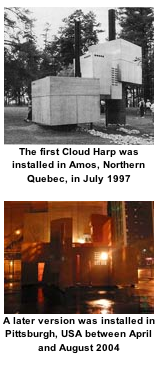
The question of what music to listen to while gazing at the clouds has finally been solved. Nicolas Reeves, a professor at the University of Quebec in Montreal, Canada, has invented The Cloud Harp – an instrument that creates music from the shape of the clouds above it. So far, it has played in six cities around the world – Amos and Montreal (Canada), Lyon (France), Hamburg (Germany), Gizycko (Poland), and Pittsburgh (US).
When the sky is blue, the harp is silent, but with the first appearance of clouds above it, the music begins. “It uses a lidar,” explains Reeves, “which is a laser beam directed at the clouds. Whatever bounces back to the instrument is measured and gives us an idea of the brightness of the cloud, as well as its height.” A controller, known as a ‘cloudist’, configures the instrument so that this information triggers and controls particular musical sounds. He then leaves it to play the music of the clouds to passers by.
Sometimes musicians are brought in to provide orchestrations by recording the samples that the harp plays.“It means that we can play the clouds of St Louis, Missouri, through an arrangement by Helmut Finski of Montreal,” explains Reeves.
In Amos, in Northern Quebec, the Cloud Harp was installed in the clearing of a park, surrounded by trees. “When there was a full moon,” Reeves remembers, “people brought their sleeping bags and stayed the night next to the harp. They just lay there listening to the clouds – it was fantastic.”
See more about The Cloud Harp at
www.cloudharp.org.



Hi, I’m an English teacher in the United Arab Emirates, and as part of our college semester’s theme on science, my class has been tasked with putting together a presentation (text/multi-media) about the science behind cloud harps. It all sounds really cool, but I had never heard of them before, so I could use anyone’s help in gathering resources about where they are/the history & science behind them, and examples of cloud music (audio and video, if possible). I like what little I’ve found, and hope to learn more. My students are female pre-freshman college students, and have also never heard about this type of music married to technology.
Many thanks for any assistance,
David Bozetarnik